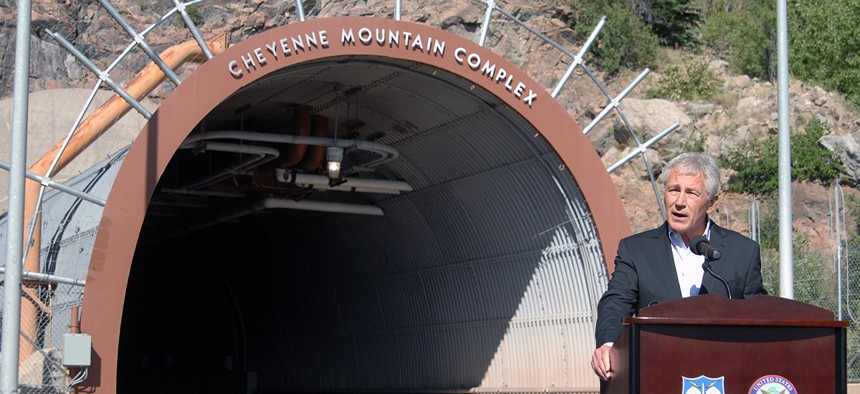
Chuck Hagel spoke at the complex in 2013. Tech. Sgt. Thomas J. Doscher/Air Force
Defense Moves More Communications Equipment into Cheyenne Mountain
Mostly abandoned a decade ago, the iconic Cold War bunker is getting an upgrade.
The Pentagon is beefing up its communications setup inside a hollowed-out section of Colorado’s Rocky Mountains less than a decade after it had largely abandoned the site.
The gear is being moved into Cheyenne Mountain to protect it from electromagnetic pulses, said Adm. William Gortney, commander of U.S. Northern Command and NORAD.
“[T]here is a lot of movement to put capability into Cheyenne Mountain and to be able to communicate in there,” Gortney said Tuesday during a news briefing at the Pentagon.
Electromagnetic pulses, or EMPs, can occur naturally or by manmade devices such as nuclear weapons. For years, the Pentagon has been working on building weapons that could fry the electronic equipment of an enemy during battle.
“Because of the very nature of the way that Cheyenne Mountain is built, it’s EMP-hardened,” Gortney said. “It wasn’t really designed to be that way, but the way it was constructed makes it that way.”
Being able to communicate during an EMP attack is important, Gortney said.
“My primary concern was: ‘Are we going to have the space inside the mountain for everybody that wants to move in there?’ ... but we do have that capability,” he said.
Last week, the Pentagon awarded defense firm Raytheon a $700-million contract to install new equipment inside the mountain. The company said the contract, which runs through 2020, will “support threat warnings and assessments for the North American Aerospace Defense Command Cheyenne Mountain Complex.”
The Pentagon’s March 30 contract announcement said Raytheon will provide sustainment services and products supporting the Integrated Tactical Warning/Attack Assessment (ITW/AA) and Space Support Contract covered systems. “The program provides ITW/AA authorities accurate, timely and unambiguous warning and attack assessment of air, missile and space threats,” it said.
Since 2013, the Pentagon has awarded contracts worth more than $850 million for work related to Cheyenne Mountain.
The Colorado complex is the embodiment of the Cold War, an era when bunkers were built far and wide to protect people and infrastructure. Cheyenne Mountain was the mother of these fallout shelters, a command center buried deep to withstand a Soviet nuclear bombardment. The complex was locked down during the Sept. 11, 2001, attacks on New York and Washington.
Air Force Space Command runs the mountain and maintains sleeping quarters, fresh water and a power station that would be used during an attack.
Almost a decade ago, NORAD pulled most of its staff out of Cheyenne Mountain and moved its command center into the basement of a headquarters building at nearby Peterson Air Force Base. Since then, Cheyenne Mountain has served as a back-up site.
Now the Cheyenne Mountain staff is set to grow again. Still, the command center at Peterson will remain operational, Gortney said.
In June 2013, then-U.S. Defense Secretary Chuck Hagel gave a speech in front of the mammoth blastproof doors on the roadway leading into the mountain.
“These facilities and the entire complex of NORAD and NORTHCOM represent the nerve center of defense for North America,” he said at the time.







